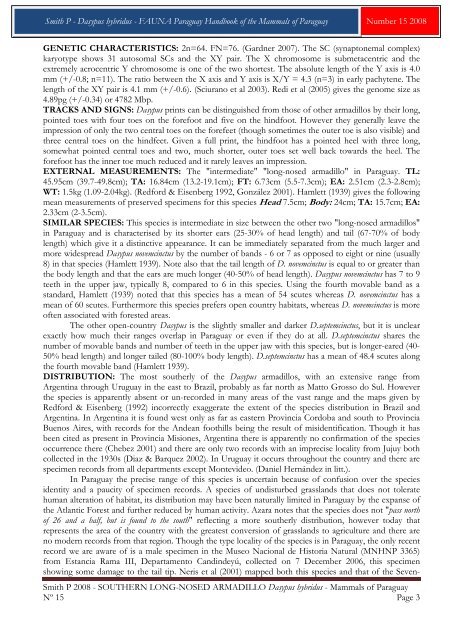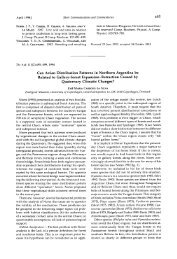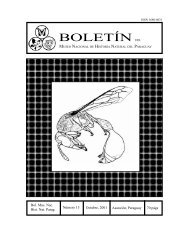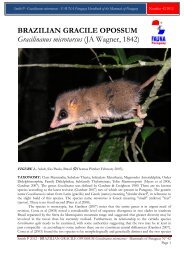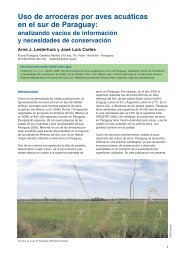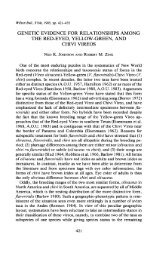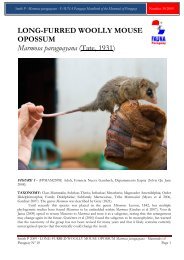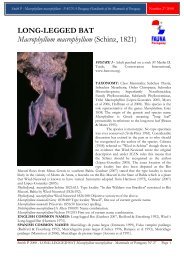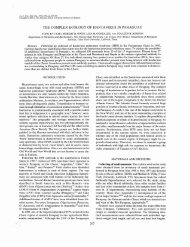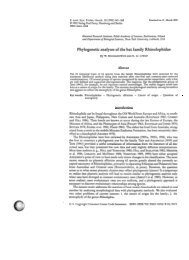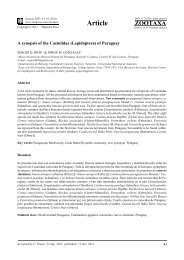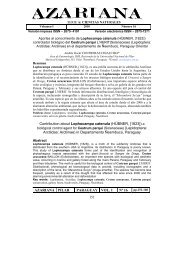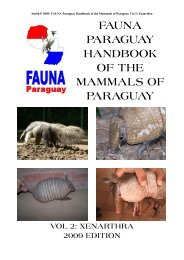Create successful ePaper yourself
Turn your PDF publications into a flip-book with our unique Google optimized e-Paper software.
<strong>Smith</strong> P - Dasypus hybridus - <strong>FAUNA</strong> <strong>Paraguay</strong> Handbook of the Mammals of <strong>Paraguay</strong> Number 15 <strong>2008</strong><br />
GENETIC CHARACTERISTICS: 2n=64. FN=76. (Gardner 2007). The SC (synaptonemal complex)<br />
karyotype shows 31 autosomal SCs and the XY pair. The X chromosome is submetacentric and the<br />
extremely acrocentric Y chromosome is one of the two shortest. The absolute length of the Y axis is 4.0<br />
mm (+/-0.8; n=11). The ratio between the X axis and Y axis is X/Y = 4.3 (n=3) in early pachytene. The<br />
length of the XY pair is 4.1 mm (+/-0.6). (Sciurano et al 2003). Redi et al (2005) gives the genome size as<br />
4.89pg (+/-0.34) or 4782 Mbp.<br />
TRACKS AND SIGNS: Dasypus prints can be distinguished from those of other armadillos by their long,<br />
pointed toes with four toes on the forefoot and five on the hindfoot. However they generally leave the<br />
impression of only the two central toes on the forefeet (though sometimes the outer toe is also visible) and<br />
three central toes on the hindfeet. Given a full print, the hindfoot has a pointed heel with three long,<br />
somewhat pointed central toes and two, much shorter, outer toes set well back towards the heel. The<br />
forefoot has the inner toe much reduced and it rarely leaves an impression.<br />
EXTERNAL MEASUREMENTS: The "intermediate" "long-nosed armadillo" in <strong>Paraguay</strong>. TL:<br />
45.95cm (39.7-49.8cm); TA: 16.84cm (13.2-19.1cm); FT: 6.73cm (5.5-7.3cm); EA: 2.51cm (2.3-2.8cm);<br />
WT: 1.5kg (1.09-2.04kg). (Redford & Eisenberg 1992, González 2001). Hamlett (1939) gives the following<br />
mean measurements of preserved specimens for this species Head 7.5cm; Body: 24cm; TA: 15.7cm; EA:<br />
2.33cm (2-3.5cm).<br />
SIMILAR SPECIES: This species is intermediate in size between the other two "long-nosed armadillos"<br />
in <strong>Paraguay</strong> and is characterised by its shorter ears (25-30% of head length) and tail (67-70% of body<br />
length) which give it a distinctive appearance. It can be immediately separated from the much larger and<br />
more widespread Dasypus novemcinctus by the number of bands - 6 or 7 as opposed to eight or nine (usually<br />
8) in that species (Hamlett 1939). Note also that the tail length of D. novemcinctus is equal to or greater than<br />
the body length and that the ears are much longer (40-50% of head length). Dasypus novemcinctus has 7 to 9<br />
teeth in the upper jaw, typically 8, compared to 6 in this species. Using the fourth movable band as a<br />
standard, Hamlett (1939) noted that this species has a mean of 54 scutes whereas D. novemcinctus has a<br />
mean of 60 scutes. Furthermore this species prefers open country habitats, whereas D. novemcinctus is more<br />
often associated with forested areas.<br />
The other open-country Dasypus is the slightly smaller and darker D.septemcinctus, but it is unclear<br />
exactly how much their ranges overlap in <strong>Paraguay</strong> or even if they do at all. D.septemcinctus shares the<br />
number of movable bands and number of teeth in the upper jaw with this species, but is longer-eared (40-<br />
50% head length) and longer tailed (80-100% body length). D.septemcinctus has a mean of 48.4 scutes along<br />
the fourth movable band (Hamlett 1939).<br />
DISTRIBUTION: The most southerly of the Dasypus armadillos, with an extensive range from<br />
Argentina through Uruguay in the east to Brazil, probably as far north as Matto Grosso do Sul. However<br />
the species is apparently absent or un-recorded in many areas of the vast range and the maps given by<br />
Redford & Eisenberg (1992) incorrectly exaggerate the extent of the species distribution in Brazil and<br />
Argentina. In Argentina it is found west only as far as eastern Provincia Cordoba and south to Provincia<br />
Buenos Aires, with records for the Andean foothills being the result of misidentification. Though it has<br />
been cited as present in Provincia Misiones, Argentina there is apparently no confirmation of the species<br />
occurrence there (Chebez 2001) and there are only two records with an imprecise locality from Jujuy both<br />
collected in the 1930s (Diaz & Barquez 2002). In Uruguay it occurs throughout the country and there are<br />
specimen records from all departments except Montevideo. (Daniel Hernández in litt.).<br />
In <strong>Paraguay</strong> the precise range of this species is uncertain because of confusion over the species<br />
identity and a paucity of specimen records. A species of undisturbed grasslands that does not tolerate<br />
human alteration of habitat, its distribution may have been naturally limited in <strong>Paraguay</strong> by the expanse of<br />
the Atlantic Forest and further reduced by human activity. Azara notes that the species does not "pass north<br />
of 26 and a half, but is found to the south" reflecting a more southerly distribution, however today that<br />
represents the area of the country with the greatest conversion of grasslands to agriculture and there are<br />
no modern records from that region. Though the type locality of the species is in <strong>Paraguay</strong>, the only recent<br />
record we are aware of is a male specimen in the Museo Nacional de Historia Natural (MNHNP 3365)<br />
from Estancia Rama III, Departamento Candindeyú, collected on 7 December 2006, this specimen<br />
showing some damage to the tail tip. Neris et al (2001) mapped both this species and that of the Seven-<br />
<strong>Smith</strong> P <strong>2008</strong> - SOUTHERN LONG-NOSED ARMADILLO Dasypus hybridus - Mammals of <strong>Paraguay</strong><br />
Nº 15 Page 3


